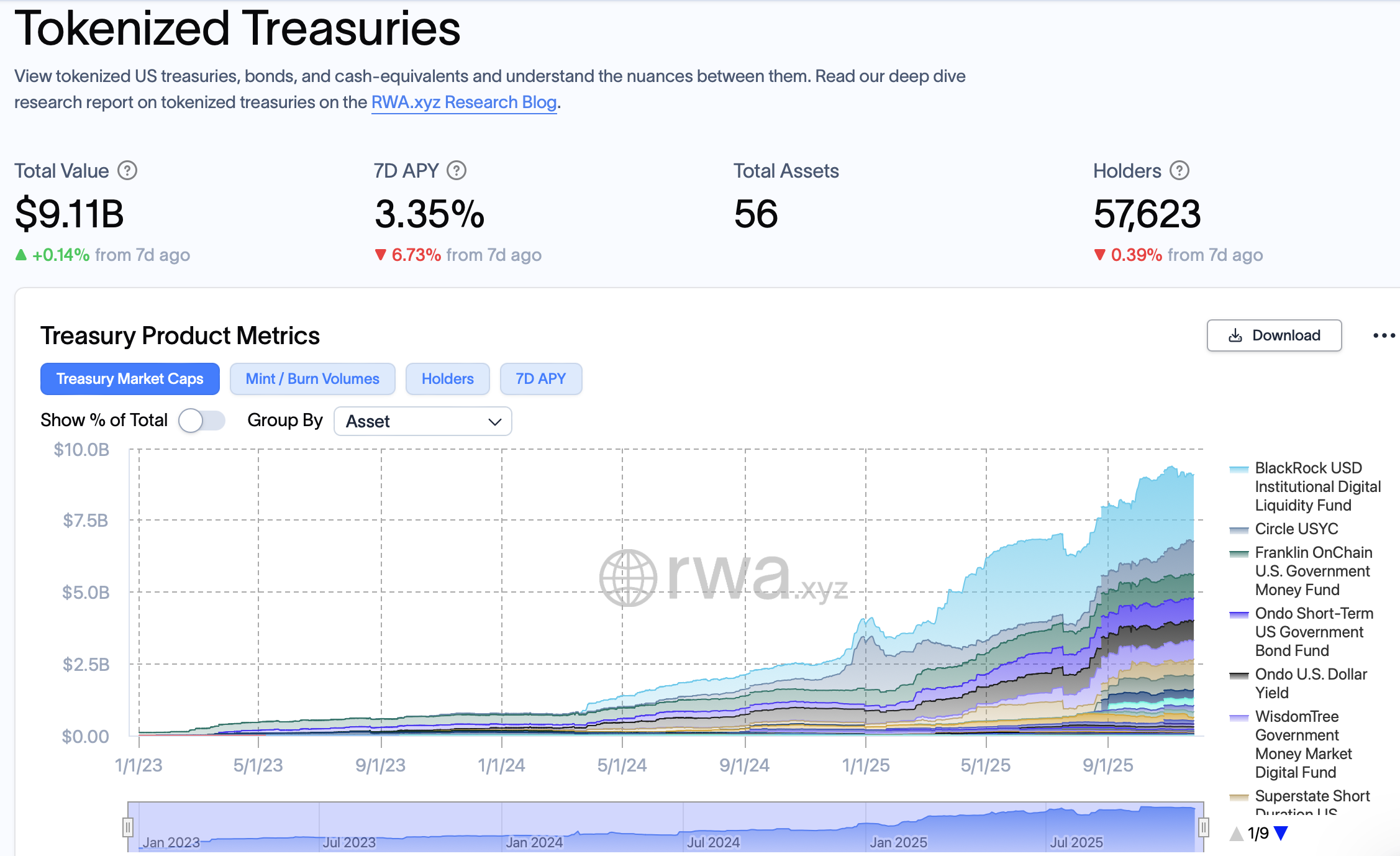The tokenized euro money market fund from Amundi allows investors to access a blockchain-based version of its traditional fund on Ethereum, streamlining order processing and enabling 24/7 trading while maintaining high-quality euro-denominated debt investments.
-
Amundi’s hybrid fund structure offers flexibility for investors choosing between traditional and tokenized shares.
-
The first transaction occurred on the Ethereum network on November 4, developed with CACEIS for tokenization infrastructure.
-
Tokenized money market funds have grown rapidly, reaching $9 billion in value by October 2025, per Bank for International Settlements data.
Discover Amundi’s tokenized euro money market fund, revolutionizing access to short-term euro debt with blockchain efficiency. Explore benefits, growth trends, and key insights—stay ahead in tokenized assets today!
What is Amundi’s Tokenized Euro Money Market Fund?
Amundi’s tokenized euro money market fund represents Europe’s largest asset manager’s entry into blockchain-based investments, offering a hybrid structure where investors can select traditional shares or a tokenized version recorded on the Ethereum network. Launched with the first transaction on November 4, this fund invests in short-term, high-quality euro-denominated debt, including money-market instruments and overnight repurchase agreements with European sovereigns. This innovation aims to enhance accessibility and operational efficiency for over 100 million retail clients managed by Amundi, which oversees approximately 2.3 trillion euros in assets from its Paris base.
How Does Tokenization Benefit Euro Money Market Funds?
Tokenization transforms traditional fund shares into digital assets on a blockchain, providing several advantages for euro money market funds like Amundi’s. It streamlines order processing by automating subscriptions and redemptions through digital systems, reducing settlement times from days to near-instantaneous. Developed in collaboration with CACEIS, a European asset-servicing group, the infrastructure includes investor wallets and a digital order system that supports 24/7 trading, broadening access to global investor channels previously limited by traditional market hours.
According to data from RWA.xyz, tokenized funds have seen explosive growth, with similar products like BlackRock’s onchain money market holding $2.3 billion in assets and Franklin Templeton’s fund surpassing $826 million by late 2025. These figures underscore the appeal of tokenization in enhancing liquidity and transparency. A Bank for International Settlements bulletin highlights that tokenized money market funds reached $9 billion by October 2025, up from $770 million at the end of 2023, reflecting institutional adoption.
However, the BIS report also cautions about potential risks, such as operational vulnerabilities if tokenized assets are used as collateral, which could introduce liquidity challenges during market stress. Experts in financial technology emphasize that while tokenization offers efficiency, robust regulatory frameworks are essential to mitigate systemic exposures. For instance, CACEIS’s role in providing secure tokenization ensures compliance with European standards, making Amundi’s fund a model for hybrid investment vehicles.
In practice, this means investors benefit from the stability of euro-denominated instruments—typically yielding low but reliable returns—combined with blockchain’s speed. Amundi’s fund focuses on high-quality assets, minimizing credit risk while leveraging Ethereum’s security for record-keeping. This approach not only appeals to institutional players but also retail investors seeking modernized access to money markets.
The asset manager’s hybrid rollout enables investors to choose between the traditional fund and a new blockchain-based version recorded on Ethereum.
Amundi, Europe’s largest asset manager, has introduced its first tokenized share class for a euro money market fund.
The fund is now offered in a hybrid structure, allowing investors to choose between the traditional version and the new blockchain-based one. The first transaction was recorded on the Ethereum network on Nov. 4.
The rollout was developed in collaboration with CACEIS, a European asset-servicing group that provided the tokenization infrastructure, investor wallets, and the digital order system used to process subscriptions and redemptions.
According to the companies, tokenizing the fund streamlines order processing, widens access to new investor channels, and enables 24/7 trading.
Amundi said the fund holds short-term, high-quality euro-denominated debt, primarily comprising money-market instruments and overnight repurchase agreements with European sovereigns.
According to the company’s website, it manages about 2.3 trillion euros ($2.6 trillion) in assets and serves more than 100 million retail clients. Amundi is based in Paris, France.
Related: Societe Generale-Forge taps Bullish to debut MiCA-licensed USDCV stablecoin
BlackRock and Franklin Templeton Drive Growth in Tokenized Funds
The tokenized euro money market fund aligns with a broader trend in the asset management industry, where major players like BlackRock and Franklin Templeton are accelerating the adoption of blockchain-based funds. In 2025, tokenized money market funds focused on US Treasurys have expanded significantly, according to RWA.xyz data. BlackRock’s onchain money market product currently holds $2.3 billion in tokenized assets, demonstrating strong institutional demand for secure, digital alternatives to traditional investments.
Franklin Templeton’s money market fund has also grown to over $826 million in assets, expanding across multiple blockchains to enhance interoperability. On November 12, Franklin Templeton announced its tokenization platform’s integration with the Canton Network, a permissioned ecosystem designed for financial institutions. This move allows the fund to operate in a controlled environment, ensuring regulatory compliance while maintaining the benefits of blockchain technology.

Tokenized US Treasury funds. Source: RWA.xyz
BlackRock has similarly broadened its tokenized fund’s reach beyond Ethereum, incorporating support for networks like Aptos, Arbitrum, Avalanche, Optimism, and Polygon. These expansions facilitate seamless cross-chain operations, appealing to a diverse range of investors and reducing dependency on a single blockchain.
The Bank for International Settlements bulletin, released on Wednesday, provides further context on this growth, noting that the total value of tokenized money market funds climbed to $9 billion by the end of October 2025. This surge from $770 million at the end of 2023 signals a maturing market for real-world asset tokenization. The report attributes this rise to improved infrastructure and regulatory clarity, particularly in Europe and the US.
Despite the optimism, the BIS warns of emerging risks. As tokenized portfolios increasingly serve as collateral in financial transactions, they could introduce new operational and liquidity vulnerabilities. For example, blockchain disruptions or smart contract failures might amplify market stresses, potentially affecting broader financial stability. Financial experts, including those from the BIS, recommend enhanced oversight and stress testing to address these concerns.
Amundi’s initiative in the euro space complements these US-focused developments, potentially paving the way for cross-Atlantic standardization in tokenized funds. By focusing on euro-denominated assets, it addresses the unique needs of European investors, such as exposure to ECB policies and regional debt markets. This hybrid model could set a precedent for other asset managers in Europe, fostering innovation while adhering to stringent MiFID II and AIFMD regulations.
In terms of performance, tokenized funds like Amundi’s maintain the low-risk profile of traditional money markets, with yields typically tracking short-term euro rates around 3-4% in 2025. The blockchain layer adds value through real-time transparency, allowing investors to track holdings via public ledgers without compromising privacy through permissioned access.
Frequently Asked Questions
What Are the Key Features of Amundi’s Tokenized Euro Money Market Fund?
Amundi’s tokenized euro money market fund features a hybrid structure with traditional and blockchain-based shares on Ethereum, investing in high-quality short-term euro debt. It enables 24/7 trading, faster processing via CACEIS infrastructure, and access for over 100 million clients, ensuring liquidity and low risk in a digital format.
How Has the Tokenized Fund Market Grown in 2025?
The tokenized fund market has boomed in 2025, with total assets reaching $9 billion by October, up significantly from prior years. Leaders like BlackRock and Franklin Templeton have driven this expansion across blockchains, offering benefits like instant settlements and global reach, as reported by the Bank for International Settlements.
Key Takeaways
- Hybrid Innovation: Amundi’s tokenized euro money market fund provides choice between traditional and blockchain versions, enhancing investor flexibility.
- Rapid Market Growth: Tokenized funds hit $9 billion in 2025, led by BlackRock’s $2.3 billion product, per RWA.xyz data.
- Risk Awareness: While efficient, adoption requires monitoring for liquidity vulnerabilities, as noted by the Bank for International Settlements.
Conclusion
Amundi’s tokenized euro money market fund marks a pivotal step in blending traditional asset management with blockchain technology, offering streamlined access to high-quality euro debt investments. As tokenized funds continue to grow—reaching $9 billion in 2025 amid expansions by BlackRock and Franklin Templeton—the industry must balance innovation with risk management. Investors are encouraged to explore these hybrid options for enhanced efficiency and 24/7 availability, positioning themselves for the evolving landscape of digital finance.
